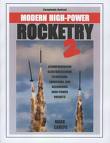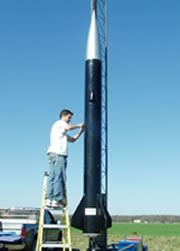Getting Started In Rocketry
Coming to a POTROCS event will give you access to people who
can assist no matter where
you
decide to start. We have hobby
pads for small
rockets, larger rods and rails for mid and high
power rockets at our launch site. Our site is in a large open area
providing plenty
of space for
rockets to land. Refer to the resource page for a list
of vendors to supply kits and motors.
Locally you can purchase hobby rockets from, Hobby Lobby, Walmart and Amarillo Hobby House..
Getting started in rocketry is not very difficult or expensive.

A simple Estes or Quest rocket will give you a basic
knowledge of what goes into a rocket. These rockets can
be purchased for less than $20. These rockets will use
A, B, C and D motors which are normally sold in 3 packs. A 3 pack of C motors cost around $10, less if you can find them on sale. Good for 3 flights in a non clustered rocket. Hobby rocket motors have various letter designations. The letter indicates the total impulse (overall productive energy) of the motor with a range. Each letter indicates a doubling of the energy from the prior range so a B motor is twice as powerful as an A and C
is four times as powerful as an A (and twice as powerful as a "B") and so on.
Motors within a given letter designation can have varying power. C and D motors
can lift model rockets to altitudes of 1000 feet or more depending on the kit. The
particular kit you purchase will have a list of acceptable motors for the kit. A good
safe practice is to use a less powerful motor for initial flights. The initial flight will
prove the flight worthiness of your rocket should there be a problem the lower power is more forgiving. Once your rocket has proven it flies straight and can recover safely you can
then move up to more powerful motors. Also keep in mind these rockets descend typically with a parachute. Windy conditions can cause a rocket to drift a significant distance sometimes in excess of 800-1000 feet. A lower impulse motor on a windy day may save a long walk or keep your rocket from getting lost. These rockets are a lot of fun and can be very challenging depending upon the level of detail and the complexity of
the rocket. Most high power rocketeers started out with hobby rockets. The skills learned with hobby rockets are applied in different ways with mid power and high power rockets.
Mid Power Rockets
Motor designations of E-G are considered mid power rockets. Mid power kits typically cost $30 to $60 which is less than a tank of gas! The motors they use have a specific impulse up to 160ns (newton seconds) compared to 10ns for a C size motor. More power means more stress on the airframe so these rockets are larger in size and usually built of sturdy materials. Rockets in this class typically are 30 to 50 inches tall. Fins are often made of light plywood or G10 fiberglass. Many rocketeers begin using epoxy instead of wood glue for a little added security. If you have experience building a hobby rocket or other building skills like RC planes you won't find mid power rockets to difficult. A motor for this size rocket cost around $17-$25 for a single motor. These motors can also be reloadable, meaning you purchase a motor case and then a propellant reload which is inserted in the case. This can reduce the cost per flight verses a single use motor. A good example of a single use motor is an Estes motor which is thrown away after each flight. A G reload cost around $14. The sound made by these motor is also much different than the "swish" of an Estes black powder motor. The first time you hear a composite E-G motor you'll probably say "wow"! As you can imagine everything is a little bigger with mid power rockets, larger parachutes, higher altitudes typically around 1300 to 2500 feet. These rockets are large enough to carry small
altimeters to record flight data as you desire more information about the flight
.
High Power
The only upper limit to what you can do in high power rocketry is money. High power
rocket motors
have letter designations
of
H-O for commercial motors. Motors larger
than O are flown but
these motors are not available commercially. An H motor
can
have an impulse up to 320ns and an O motor up to 40,960ns. At this level of the
hobby it is highly suggested to begin doing
some reading to educate your self about
the skills required. A
good first book is Modern High Power Rocketry II by Mark
Canepa.
This book
gives a very good overview of the various aspects
of high power
rocketry. In order to use/purchase a
motor with an
impulse of H or higher a certification
process must be completed. Tripoli and NAR both
have level 1, 2 and 3. Level 1 is for
motors H-I,
level 2 for J-L and level 3 for M and higher. The level one certification
consists of flying the rocket on a L1 motor and safely recovering the rocket with no damage to the rocket. For the sake of a beginning discussion we won't go into Level 3 certification process. Level 2 has the same requirement as level 1 plus a test must be passed showing the rocketeers general knowledge of rockets flight and propulsion. A level 1 rocket can cost $100 or more once everything is purchased the upper limit is really up to the builder. Level 1 motor reloads range in price from $22 to $60 per flight. It is very common for L1 rockets to have dual deployment. Dual deployment is when an altimeter is used to determine the apogee. At apogee a powder charge is blown to deploy a small drogue chute. The purpose of the drogue chute is to bring the rocket down faster than a large main, thus reducing how far the rocket drifts. When the rocket reaches a predetermined altitude another charge fires releasing the main parachute for a gentle touch down. Altitudes of L1 rockets normally range from 1500 ft up to 4000. Epoxy is the standard glue along with light plywood, G10 or composite materials for fins. Size is usually 40 inches up to 90 inches. Motors
often produce different color flames from a black smoke to reds, greens, blues and other colors. Chute size is 36 inches up to around 60 inches depending upon the requirement of the rocket.
Scratch Building
Computer programs like Rocksim allow the rocketeer to design whatever the
imagination desires. The program will
determine things like center of pressure,
center of gravity, descent rate and other
parameters. Flight characteristics
can also be run to project maximum altitude,
acceleration, velocity, time to
apogee etc. A program like Rocksim can allow
you to create simple
hobby rockets up to very complex high power rockets.
There are other
programs also available which perform similar functions.
Good luck and good flying!!

